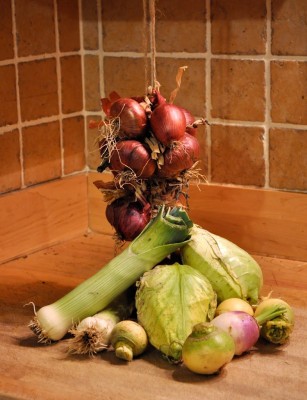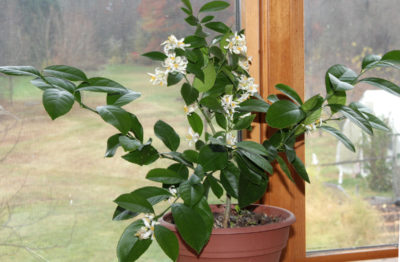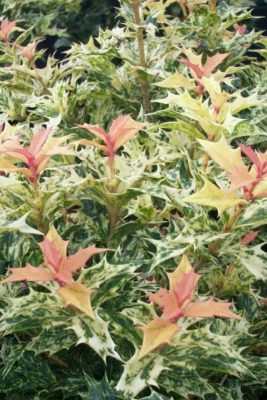ALMOST LIKE SUMMER
Fresh Veggies
When I was a child, it seemed that winter vegetables were mostly peas and diced carrots, conveniently poured frozen out of plastic bags into pots of boiling water. Yuk! Winter notwithstanding, my backyard garden still offers plenty of fresh winter vegetables. Let’s have a look. Kale, of course, looks unfazed by snow and plummeting temperatures. Not only does it look unfazed; it also tastes very delicious.
More surprising is the endive that I planted back in August, then covered beneath a “tunnel” of clear plastic and slightly insulating row cover held aloft by metal hoops in late October. Temperatures about a week ago went as low as -8° Fahrenheit! Thanks to the additional insulation from almost a foot of snow, now melted, the endive is still lush and tasty.
The rest of winter’s fresh garden vegetables are not in the garden. Most are in plywood boxes in cold storage, first in my mudroom, then moved out to my cooler.  (The cooler is an insulated room cooled with an air conditioner that has been tricked, with a device called CoolBot, into bringing the temperature down just below 40° F.) One box houses Hakurei turnips, Watermelon radishes, and Daikon radishes picked around the middle of December.
(The cooler is an insulated room cooled with an air conditioner that has been tricked, with a device called CoolBot, into bringing the temperature down just below 40° F.) One box houses Hakurei turnips, Watermelon radishes, and Daikon radishes picked around the middle of December.
The same day I pulled the turnips and radishes, I also dug up leeks, now nestled into another box. With snow cover, both leeks and turnips probably would survive winter out in the garden, but reaching into a box is easier than chopping through ice and snow out in the garden to get at these vegetables.
Yet another box has a few heads of cabbage, also harvested that day in December. Lopping off the outer leaves, which anyway were looking ragged and slug-eaten, cuts water loss from the tight heads and keeps them fresh. One more box is packed full of napa type Chinese cabbages, good for “Asian slaw” or stir fry.
Most years I would have braids of onions also. Not this year. Crop failure. All the onions, both direct-seeded and grown from my transplants, didn’t grow large enough to bother storing. The problem was a clog, too long undetected, in the water line to the seasonal irrigation pump at, evidently, a critical time in onion bulb development.
(I also have a 400 square foot greenhouse packed full of fresh, growing lettuce, mustard greens, arugula, celery, claytonia, kale, chard, and mâche, with a little fresh dill, cilantro, and parsley. But that’s a whole other story.)
Summer Berries
I may be addicted to blueberries. I now eat them pretty much every morning year ‘round. That’s fresh blueberries beginning at the end of June, and frozen ones from mid-September on. I pace myself. The frozen blueberry season opens with about 70 bags (each bag about 5 cups) in the freezer, enough to keep us “berry happy” on into June.

I highly recommend planting blueberries. They are easy to grow organically, the plants are beautiful, and the berries are very healthful and taste great. They’re also easy to freeze: Just spread them on a tray until frozen, then pack them into bags. Their two main requirements are suitable soil, easily made so, and protection from birds, with netting. Each bush will net you 8 pounds, or more, of berries.
Thawed in the refrigerator, the berries taste as good as fresh ones. Or maybe I believe that only because in late December it’s been so long since I’ve had a fresh blueberry.
Olfactory Romance
Man cannot, of course, live by bread alone. I could use some fragrance, some olfactory hint of spring — or summer, or fall. Years ago, I grew “many-flowered jasmine” (Jasminium polyantha). A misnomer for my plant. Its fragrance was heavenly but it only coughed up a few blossoms each winter, despite my subjecting it to a period of temperatures below 60 degrees F. and some drought to give it a rest before it (was supposed to) burst into flowering abundance.
Gardenia was another one of my plants for winter fragrance. It did bloom in winter, late winter, and its fragrance was heavenly. But it proved to be a magnet for scale insects, one of the most difficult house plant pests to control organically. Both plants have long ago been composted.
I’m now eagerly awaiting blossoms on my Meyer lemon plant. The plant is easy to bring into bloom, and there’s the added bonus of delicious lemons. Being a hybrid of lemon and sweet orange, Meyer lemon has a slightly different flavor from that of lemons.

The other plant to — reliably, I hope — blossom now, in early winter is sweet osmanthus (Osmanthus fragrans), specifically the variety Goshiki. Why Goshiki? Because it has variegated leaves, green and white with splashes of pink, spiny like those of holly.  It’s cold-hardy to Zone 6. My plan is to grow it in a pot to bring indoors to a cool sunny window in late fall to spend the winter.
It’s cold-hardy to Zone 6. My plan is to grow it in a pot to bring indoors to a cool sunny window in late fall to spend the winter.
This is all a pipe dream so far because all I have is a spindly stem I cut to root from a plant beckoning me from a sidewalk near Philadelphia. The cutting doesn’t look hopeful. The quest begins.


Looking forward to the “whole other story” about growing vegies in your greenhouse. Wondering how I could duplicate a greenhouse experience in my house, as well. As always, great posts. Thank you, Linda
Story will be forthcoming. It would be hard to duplicate greenhouse experience in house: less light in house and less room for real production. Still, you could grow a limited amount of greens with a very sunny window and/or supplemental lighting. An outdoor cold frame would be much more productive, how much depending on your management and climate.
Hi Lee,
Thanks for the photos and descriptions of your year-end farmden cornucopia. I still have a few daikon radish plants in the raised beds of my co-op garden.
I’m still sprouting a variety of seeds and beans; half of the sprouts go to a vegan friend.
I’m trying to grow micro-greens from a kit I purchased. Several failures, but in two more days I can harvest the “spicy mix” and the arugala. Do you have any experience with this method?
Nice to hear from you and about your garden Jerry. I don’t know if you saw a recent blog post about English walnuts, but the seedlings I got at the 2006(?) NYNG meeting in Saratoga bore heavily this year. Squirrels got all but one, which was delicious. I’m going to keep the squirrels off them in 2021!
I would love to have fresh fruit and veg through winter. Thus is the first year fir my 8’x12’ greenhouse. Has a small heater and louvered vent. I tried peppers and eggplant. But got an infestation of aphids. First tried insecticidal soap then Neem. Neither helped. Getting ready to toss. Wondering if Pyrethrin might work?
Mike mount Joy, PA
I avoid pyrethrin only because it’s toxic to a lot of things. Depending on what your winters are like, it might be hard or impossible to fruit eggplant and pepper through winter; temperatures too cool and light too low. I would opt for palnts that like cool weather and go into at least a partial rest in winter. Loquats?
Artichokes in the basement.
I have 5 pots of ‘chokes, Imperial Star, from last summer that had negligible results.
I cut them to the crown and placed the pots in the basement hopping for major results in 2021. You think that will work? I live in northwest CT.
Don
Yes, that should work as long as your basement in cold enough to keep them dormant.
Great to read what you have growing as we’re down to just cool season herbs and kale in our covered raised bed. I’m hoping to get it together to have a range of late season/ winter vegetables next year.
Alas, we’re out of blueberries (though we do have lots of elderberries left). But we’ve followed your advice from several books, and watched your great seminar this summer, and get good yields from as many highbush blueberries as we can fit (just 6, blueray and bluecrop, fourth season coming up). Thinking of adding drip irrigation from rain barrels this year after the drought we had this summer (Pittsburgh).
Birds have driven us crazy; we have enough raspberries to share but we want the more limited blueberries for ourselves. Even with a blueberry temple, they come in at the bottom of the 3/4″ netting, and worse, they get stuck. Does this happen to you? Do you have any details to share on the perimeter of your netting?
Thanks for the writing and Happy New Year!
Rabbits tried to eat through my netting so I put 18 inch high chicken wire at the base all around the temple. It Keep out birds also. As far as drip irrigation with rain barrels, they have to be elevated significantly (10-15 feet!) to yield enough pressure, typically about 10 psi although there are some drip lines that work at very low pressure. Alternatively, there are solar powered pumps that can do the job. See, for example https://www.semprius.com/solar-rain-barrel-pump.
Thank you for your beautiful and inspiring newsletter. I have tried to grow blueberries without luck, the soil is not acidic enough. Have added pine needles and sulpher. Any other suggestions.
So a soil test to see how much sulfur you actually need. Pine needles will not acidify a soil. Make sure drainage is good. Mulch to keep weeds at bay. Water regularly, about 3/4 gallon per one square foot spread of branches.
Your comments on the abundance of blueberries in your garden got me imagining what you harvesting such volume would look like. Have you considered posting some videos of harvesting some of your fruits and vegetables? It seems like so much information and literature is available about the type of plant, history, cultural requirements, and so on but relatively little about the actual technique and tips of harvesting. That would speak to timing of harvest (for all sorts of reasons), efficiency, and loads of nuanced information a video could deliver from an experienced gardener like yourself.
Just a thought.
Always love your posts. Thanks for passing along your knowledge!
Okay Steve, I’ll try to get that together this growing season.
This would also be very helpful to accompany your (very thorough) written descriptions of how to harvest European pears.
How do you get a Meyer Lemon to bloom? Mine is about 3 feet tall, 8 or so years old, and has never bloomed. On my patio in winter, outside in summer here in Corvallis Oregon.
Abundant sunlight.